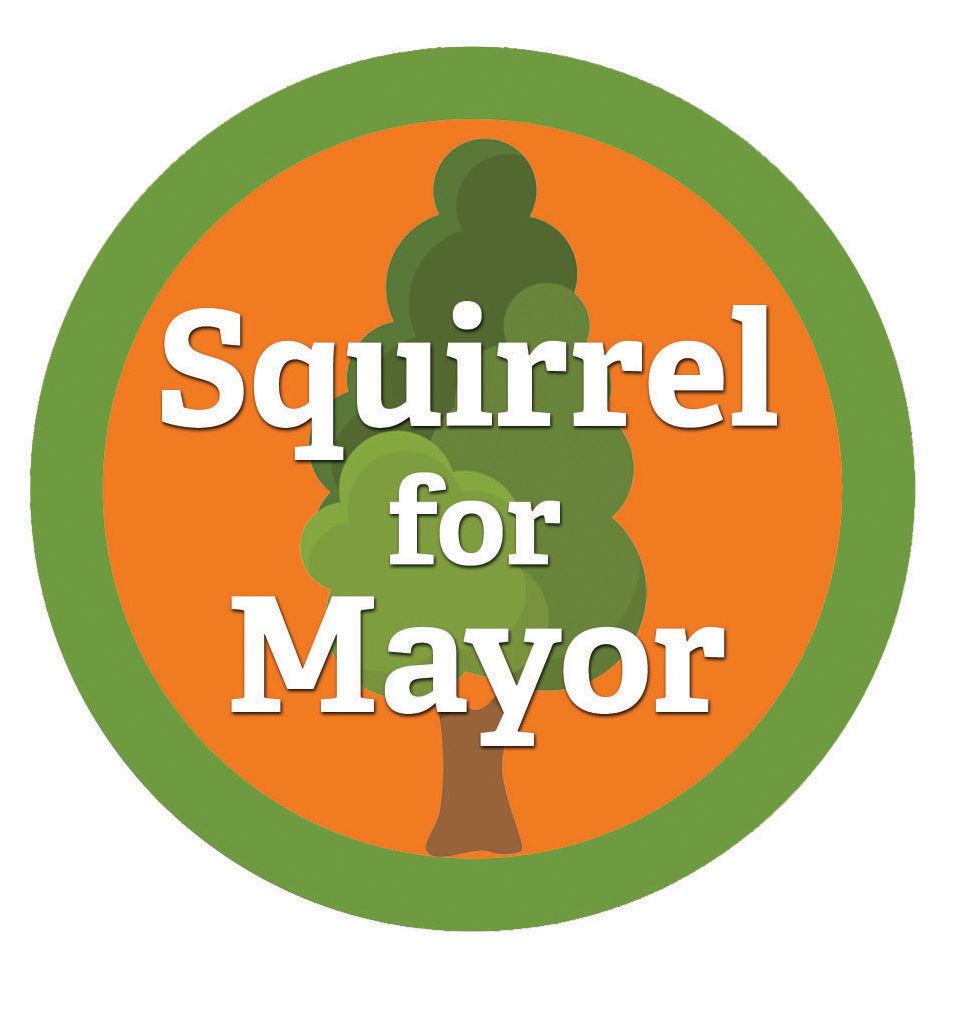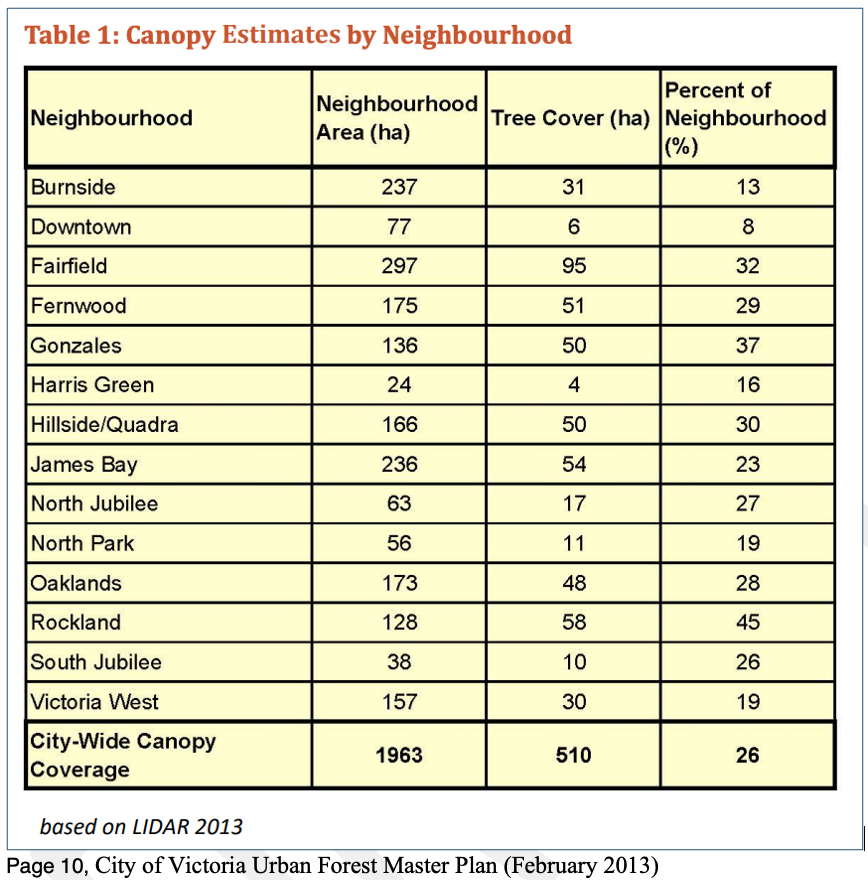Council Member Motion
For the Committee of the Whole Meeting of April 3rd, 2025
COTW Video segment:
https://pub-victoria.escribemeetings.com/Meeting.aspx?Id=f613a2e9-ce96-43b6-aca8-b281afcdaf54&Agenda=Merged&lang=English&Item=23&Tab=attachments
Motion (.pdf)
https://pub-victoria.escribemeetings.com/filestream.ashx?DocumentId=101687
BACKGROUND:
A significant value for Victorians is nature, our climate, our hills, our natural green areas, and our urban forest. Section 4, Blue Green Networks of the 2025 DRAFT OCP, includes a brief description of the City’s need for attention to the Urban Forest. The Urban Forest city-wide canopy cover is about 28 per cent (Draft OCP).
The City of Victoria Urban Forest Master Plan (February 2013) recommends that a canopy cover goal of 40% would be appropriate for cities in the Pacific Northwest. Table 1 of that document, citing a 2013 LIDAR analyses, states Victoria’s City Wide Canopy Coverage was 26%.
(see Appendix for list of reference documents).
The City’s Tree Protection Bylaw’s (21-035) Tree Reserve cash-in-lieu program receives funds when trees are removed from private property (75% of the urban forest) in order to replace them on public property (25% of the urban forest). While the City performs an appraisal value for trees on public property which could be valued between $6000 and $100,000 per tree to compensate for the value of the tree, installation and maintenance of the replacement tree, the cash-in-lieu fee associated with a deficit of the tree minimum at the end of a project on private land is $2000 per tree.
Therefore, there are not enough funds collected from private property tree removals to plant and maintain replacement trees on public property. The City cannot replace trees on private land and achieve a 40% tree canopy target by 2050. We recognize higher costs that the City will need to increase costs for maintenance of trees removed from private property and maintained on public property.
An increase in fees for cash-in-lieu would incentivize developers to replace more trees and conversely, to disincentivize expedient tree removal.
RECOMMENDATIONS:
That Council direct staff to
- Set 5-year tree canopy (growth) targets within the OCP supporting a 40% city-wide 2050 tree canopy goal.
- Set five-year neighbourhood-level planting targets within the OCP to reach a 40% tree canopy by 2050.
3. Raise cash-in-lieu fees when a development does not meet the Tree Protection Bylaw tree minimum on private property from $2000 to $5000 per tree to go into the Tree Reserve Fund, to reach 40% tree canopy by 2050.
Outcome:
1. Set 5-year tree canopy (growth) targets within the OCP supporting a 40% city-wide 2050 tree canopy goal. (APPROVED)
2. Set five-year neighbourhood-level planting targets within the OCP to reach a 40% tree canopy by 2050. (APPROVED – Amended to add “city-wide” to indicate that the Neighbourhood targets can vary from 40% but contribute to the city average of 40% and passed 5 to 3, Dell, Kim, and Thompson voted against.)
3. Raise cash-in-lieu fees when a development does not meet the Tree Protection Bylaw tree minimum on private property from $2000 to $5000 per tree to go into the Tree Reserve Fund, to reach 40% tree canopy by 2050. (This has been moved to a later date so that staff can report back)
Additional Information
The relationship between land use development and tree canopy is a dynamic one; each influences the other. Our community’s aspirations for the future, as outlined in the Official Community Plan (OCP), reflect our values. The Urban Forest Master Plan lays out specific goals that guide us toward realizing this vision. Trees, particularly those on private properties, play a crucial role in enhancing the ecosystem services that benefit our residents. By increasing the cash-in-lieu fee from $2,000 to $5,000 per tree that falls short of the required minimum, we create a strong incentive for developers to comply with the Tree Protection Bylaw rather than diminishing our community’s green resources. Even the addition of a single tree per development can have a meaningful impact on our ecosystem without incurring costs for the city in terms of planting and maintenance.
Cash-in-lieu charges are for each tree that does not meet the required minimum on a property at a 1:1 ratio. This approach differs from the 3:1 tree retention credit ratio that encourages the preservation of large, healthy specimen trees. It’s important to note that trees retained and replacements made to meet the minimum requirements are exempt from these cash-in-lieu charges.
While the City recognizes the value of trees on public lands when calculating ecosystem services, cash-in-lieu payments have not successfully compensated for tree loss. Over the past three years, the City has collected $1,047,000 from developments that fell short of the tree minimum, resulting in a net loss of 523 trees from private properties. The cost of planting trees in boulevards is at least $1,250 each, and in areas with hardscaping, like linear parks, the cost rises to $10,000 or more, not to mention the ongoing maintenance required. Many municipalities still use outdated cash-in-lieu fees that don’t reflect the actual costs of planting trees on public land, leading them to operate at a loss. By raising these fees, the City of Victoria can enhance tree canopy growth, discourage unnecessary tree removals on private properties, and better support the budget necessary for maintaining ecosystem services provided by City staff on public land.
There are important points, and assist towards a positive impact on residents’ physical and mental health and a greener, more sustainable community.
Deliberation related to neighbourhoods:
Derrick Newman, City of Victoria Director of Parks, wants to look at neighbourhood typology rather than “artificial boundaries within the city limits.” Councillor Caradonna said that the “point of the one city OCP is to move away from neighbourhood level plans, and what I’m seeing and hearing from staff is that number 2 creates a lot of challenges because then we’re back to figuring out what’s going on at the neighbourhood level,” and that he “does not want to move us backwards to neighbourhood plans.”


